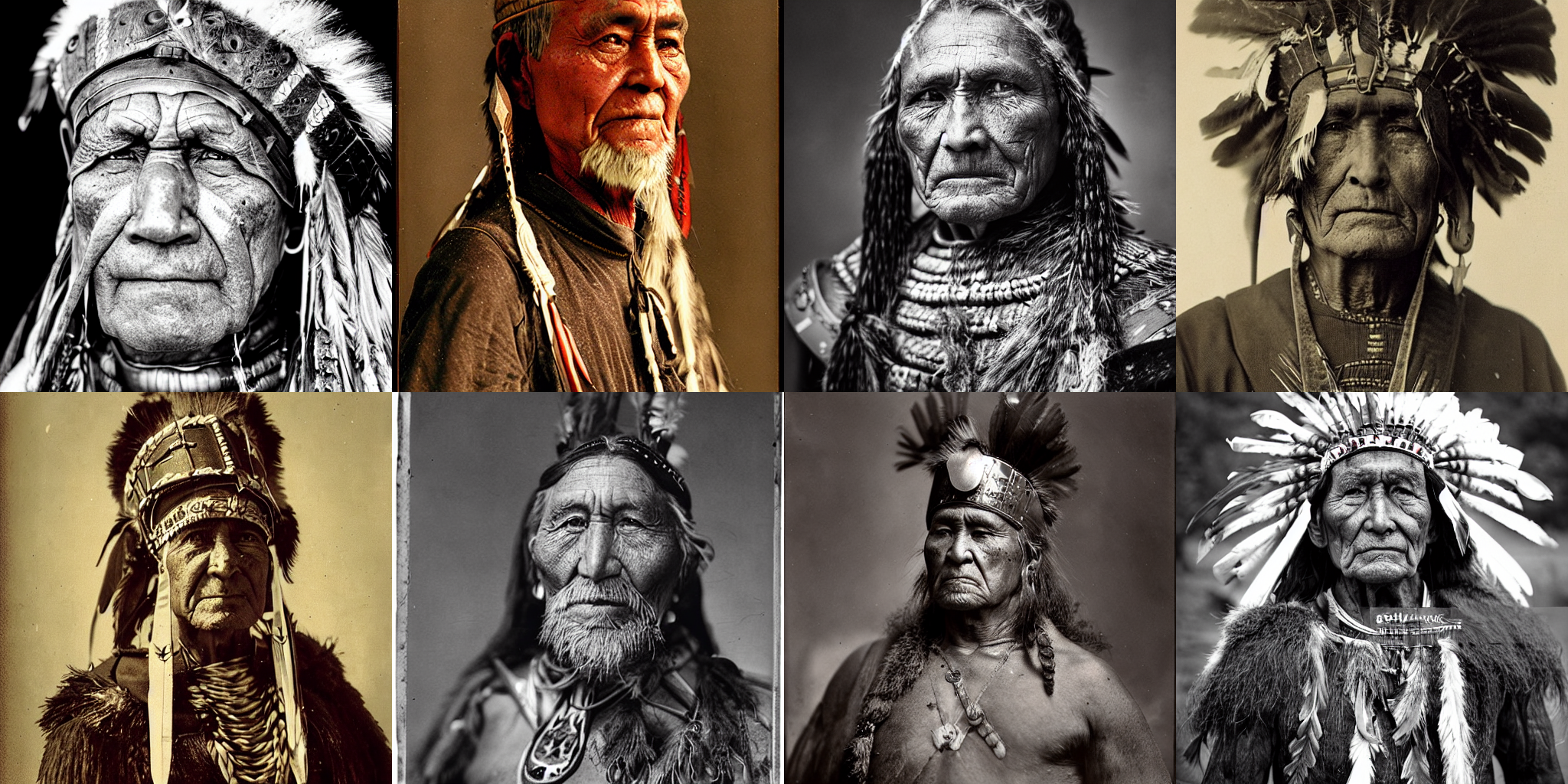# 有效且高效的扩散
[[open-in-colab]]
让 [`DiffusionPipeline`] 生成特定风格或包含你所想要的内容的图像可能会有些棘手。 通常情况下,你需要多次运行 [`DiffusionPipeline`] 才能得到满意的图像。但是从无到有生成图像是一个计算密集的过程,特别是如果你要一遍又一遍地进行推理运算。
这就是为什么从pipeline中获得最高的 *computational* (speed) 和 *memory* (GPU RAM) 非常重要 ,以减少推理周期之间的时间,从而使迭代速度更快。
本教程将指导您如何通过 [`DiffusionPipeline`] 更快、更好地生成图像。
首先,加载 [`runwayml/stable-diffusion-v1-5`](https://huggingface.co/runwayml/stable-diffusion-v1-5) 模型:
```python
from diffusers import DiffusionPipeline
model_id = "runwayml/stable-diffusion-v1-5"
pipeline = DiffusionPipeline.from_pretrained(model_id, use_safetensors=True)
```
本教程将使用的提示词是 [`portrait photo of a old warrior chief`] ,但是你可以随心所欲的想象和构造自己的提示词:
```python
prompt = "portrait photo of a old warrior chief"
```
## 速度
💡 如果你没有 GPU, 你可以从像 [Colab](https://colab.research.google.com/) 这样的 GPU 提供商获取免费的 GPU !
加速推理的最简单方法之一是将 pipeline 放在 GPU 上 ,就像使用任何 PyTorch 模块一样:
```python
pipeline = pipeline.to("cuda")
```
为了确保您可以使用相同的图像并对其进行改进,使用 [`Generator`](https://pytorch.org/docs/stable/generated/torch.Generator.html) 方法,然后设置一个随机数种子 以确保其 [复现性](./using-diffusers/reproducibility):
```python
import torch
generator = torch.Generator("cuda").manual_seed(0)
```
现在,你可以生成一个图像:
```python
image = pipeline(prompt, generator=generator).images[0]
image
```
在 T4 GPU 上,这个过程大概要30秒(如果你的 GPU 比 T4 好,可能会更快)。在默认情况下,[`DiffusionPipeline`] 使用完整的 `float32` 精度进行 50 步推理。你可以通过降低精度(如 `float16` )或者减少推理步数来加速整个过程
让我们把模型的精度降低至 `float16` ,然后生成一张图像:
```python
import torch
pipeline = DiffusionPipeline.from_pretrained(model_id, torch_dtype=torch.float16, use_safetensors=True)
pipeline = pipeline.to("cuda")
generator = torch.Generator("cuda").manual_seed(0)
image = pipeline(prompt, generator=generator).images[0]
image
```
这一次,生成图像只花了约 11 秒,比之前快了近 3 倍!
💡 我们强烈建议把 pipeline 精度降低至 `float16` , 到目前为止, 我们很少看到输出质量有任何下降。
另一个选择是减少推理步数。 你可以选择一个更高效的调度器 (*scheduler*) 可以减少推理步数同时保证输出质量。您可以在 [DiffusionPipeline] 中通过调用compatibles方法找到与当前模型兼容的调度器 (*scheduler*)。
```python
pipeline.scheduler.compatibles
[
diffusers.schedulers.scheduling_lms_discrete.LMSDiscreteScheduler,
diffusers.schedulers.scheduling_unipc_multistep.UniPCMultistepScheduler,
diffusers.schedulers.scheduling_k_dpm_2_discrete.KDPM2DiscreteScheduler,
diffusers.schedulers.scheduling_deis_multistep.DEISMultistepScheduler,
diffusers.schedulers.scheduling_euler_discrete.EulerDiscreteScheduler,
diffusers.schedulers.scheduling_dpmsolver_multistep.DPMSolverMultistepScheduler,
diffusers.schedulers.scheduling_ddpm.DDPMScheduler,
diffusers.schedulers.scheduling_dpmsolver_singlestep.DPMSolverSinglestepScheduler,
diffusers.schedulers.scheduling_k_dpm_2_ancestral_discrete.KDPM2AncestralDiscreteScheduler,
diffusers.schedulers.scheduling_heun_discrete.HeunDiscreteScheduler,
diffusers.schedulers.scheduling_pndm.PNDMScheduler,
diffusers.schedulers.scheduling_euler_ancestral_discrete.EulerAncestralDiscreteScheduler,
diffusers.schedulers.scheduling_ddim.DDIMScheduler,
]
```
Stable Diffusion 模型默认使用的是 [`PNDMScheduler`] ,通常要大概50步推理, 但是像 [`DPMSolverMultistepScheduler`] 这样更高效的调度器只要大概 20 或 25 步推理. 使用 [`ConfigMixin.from_config`] 方法加载新的调度器:
```python
from diffusers import DPMSolverMultistepScheduler
pipeline.scheduler = DPMSolverMultistepScheduler.from_config(pipeline.scheduler.config)
```
现在将 `num_inference_steps` 设置为 20:
```python
generator = torch.Generator("cuda").manual_seed(0)
image = pipeline(prompt, generator=generator, num_inference_steps=20).images[0]
image
```
太棒了!你成功把推理时间缩短到 4 秒!⚡️
## 内存
改善 pipeline 性能的另一个关键是减少内存的使用量,这间接意味着速度更快,因为你经常试图最大化每秒生成的图像数量。要想知道你一次可以生成多少张图片,最简单的方法是尝试不同的batch size,直到出现`OutOfMemoryError` (OOM)。
创建一个函数,为每一批要生成的图像分配提示词和 `Generators` 。请务必为每个`Generator` 分配一个种子,以便于复现良好的结果。
```python
def get_inputs(batch_size=1):
generator = [torch.Generator("cuda").manual_seed(i) for i in range(batch_size)]
prompts = batch_size * [prompt]
num_inference_steps = 20
return {"prompt": prompts, "generator": generator, "num_inference_steps": num_inference_steps}
```
设置 `batch_size=4` ,然后看一看我们消耗了多少内存:
```python
from diffusers.utils import make_image_grid
images = pipeline(**get_inputs(batch_size=4)).images
make_image_grid(images, 2, 2)
```
除非你有一个更大内存的GPU, 否则上述代码会返回 `OOM` 错误! 大部分内存被 cross-attention 层使用。按顺序运行可以节省大量内存,而不是在批处理中进行。你可以为 pipeline 配置 [`~DiffusionPipeline.enable_attention_slicing`] 函数:
```python
pipeline.enable_attention_slicing()
```
现在尝试把 `batch_size` 增加到 8!
```python
images = pipeline(**get_inputs(batch_size=8)).images
make_image_grid(images, rows=2, cols=4)
```
以前你不能一批生成 4 张图片,而现在你可以在一张图片里面生成八张图片而只需要大概3.5秒!这可能是 T4 GPU 在不牺牲质量的情况运行速度最快的一种方法。
## 质量
在最后两节中, 你要学习如何通过 `fp16` 来优化 pipeline 的速度, 通过使用性能更高的调度器来减少推理步数, 使用注意力切片(*enabling attention slicing*)方法来节省内存。现在,你将关注的是如何提高图像的质量。
### 更好的 checkpoints
有个显而易见的方法是使用更好的 checkpoints。 Stable Diffusion 模型是一个很好的起点, 自正式发布以来,还发布了几个改进版本。然而, 使用更新的版本并不意味着你会得到更好的结果。你仍然需要尝试不同的 checkpoints ,并做一些研究 (例如使用 [negative prompts](https://minimaxir.com/2022/11/stable-diffusion-negative-prompt/)) 来获得更好的结果。
随着该领域的发展, 有越来越多经过微调的高质量的 checkpoints 用来生成不一样的风格. 在 [Hub](https://huggingface.co/models?library=diffusers&sort=downloads) 和 [Diffusers Gallery](https://huggingface.co/spaces/huggingface-projects/diffusers-gallery) 寻找你感兴趣的一种!
### 更好的 pipeline 组件
也可以尝试用新版本替换当前 pipeline 组件。让我们加载最新的 [autodecoder](https://huggingface.co/stabilityai/stable-diffusion-2-1/tree/main/vae) 从 Stability AI 加载到 pipeline, 并生成一些图像:
```python
from diffusers import AutoencoderKL
vae = AutoencoderKL.from_pretrained("stabilityai/sd-vae-ft-mse", torch_dtype=torch.float16).to("cuda")
pipeline.vae = vae
images = pipeline(**get_inputs(batch_size=8)).images
make_image_grid(images, rows=2, cols=4)
```
### 更好的提示词工程
用于生成图像的文本非常重要, 因此被称为 *提示词工程*。 在设计提示词工程应注意如下事项:
- 我想生成的图像或类似图像如何存储在互联网上?
- 我可以提供哪些额外的细节来引导模型朝着我想要的风格生成?
考虑到这一点,让我们改进提示词,以包含颜色和更高质量的细节:
```python
prompt += ", tribal panther make up, blue on red, side profile, looking away, serious eyes"
prompt += " 50mm portrait photography, hard rim lighting photography--beta --ar 2:3 --beta --upbeta"
```
使用新的提示词生成一批图像:
```python
images = pipeline(**get_inputs(batch_size=8)).images
make_image_grid(images, rows=2, cols=4)
```
非常的令人印象深刻! Let's tweak the second image - 把 `Generator` 的种子设置为 `1` - 添加一些关于年龄的主题文本:
```python
prompts = [
"portrait photo of the oldest warrior chief, tribal panther make up, blue on red, side profile, looking away, serious eyes 50mm portrait photography, hard rim lighting photography--beta --ar 2:3 --beta --upbeta",
"portrait photo of a old warrior chief, tribal panther make up, blue on red, side profile, looking away, serious eyes 50mm portrait photography, hard rim lighting photography--beta --ar 2:3 --beta --upbeta",
"portrait photo of a warrior chief, tribal panther make up, blue on red, side profile, looking away, serious eyes 50mm portrait photography, hard rim lighting photography--beta --ar 2:3 --beta --upbeta",
"portrait photo of a young warrior chief, tribal panther make up, blue on red, side profile, looking away, serious eyes 50mm portrait photography, hard rim lighting photography--beta --ar 2:3 --beta --upbeta",
]
generator = [torch.Generator("cuda").manual_seed(1) for _ in range(len(prompts))]
images = pipeline(prompt=prompts, generator=generator, num_inference_steps=25).images
make_image_grid(images, 2, 2)
```
## 最后
在本教程中, 您学习了如何优化[`DiffusionPipeline`]以提高计算和内存效率,以及提高生成输出的质量. 如果你有兴趣让你的 pipeline 更快, 可以看一看以下资源:
- 学习 [PyTorch 2.0](./optimization/torch2.0) 和 [`torch.compile`](https://pytorch.org/docs/stable/generated/torch.compile.html) 可以让推理速度提高 5 - 300% . 在 A100 GPU 上, 推理速度可以提高 50% !
- 如果你没法用 PyTorch 2, 我们建议你安装 [xFormers](./optimization/xformers)。它的内存高效注意力机制(*memory-efficient attention mechanism*)与PyTorch 1.13.1配合使用,速度更快,内存消耗更少。
- 其他的优化技术, 如:模型卸载(*model offloading*), 包含在 [这份指南](./optimization/fp16).







